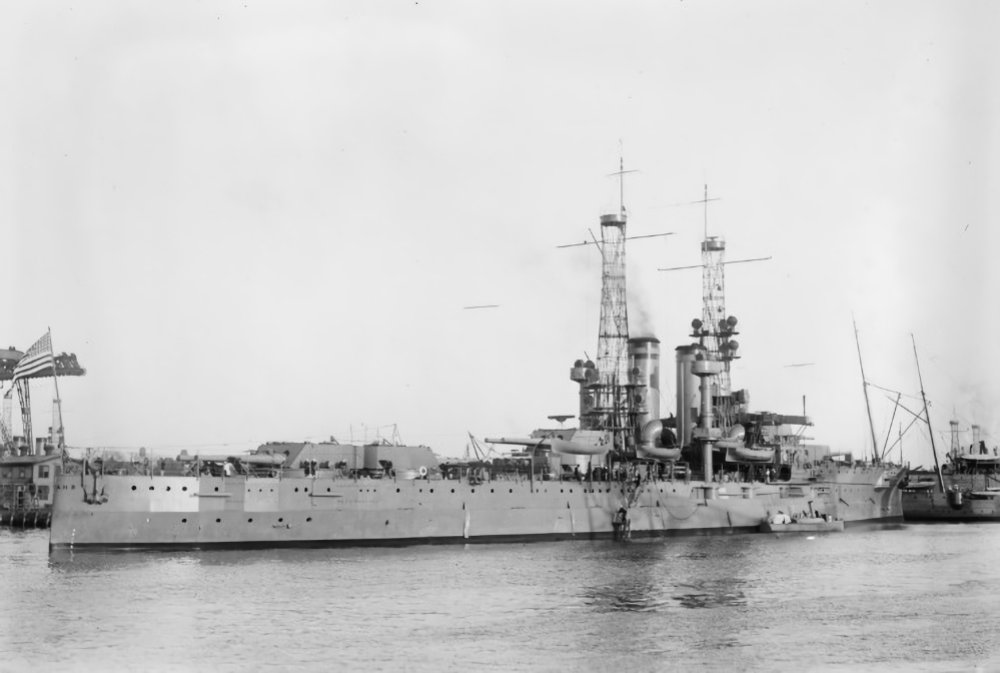USS Utah BB-31
The USS Utah (BB-31) was the second vessel of the US Navy’s Florida-class dreadnought battleships. Constructed at the New York Shipbuilding Corporation, the ship was laid down in 1909 and commissioned on August 31, 1911. The vessel’s original configuration featured a main battery of ten 12-inch/45 calibre guns mounted in five twin centreline turrets. Initial deployment involved assignment to the Atlantic Fleet, where she participated in standard fleet manoeuvres. A key early action included the transport of personnel for the United States occupation of Veracruz in April 1914. During the period of US involvement in World War I, Utah operated from Bantry Bay, Ireland. Her primary function involved serving as a heavy-unit element for the Sixth Battle Squadron, providing distant cover for Allied convoys against potential German surface raiders. Following the armistice, the ship was utilized for transport and training operations throughout the 1920s.
Conversion to Auxiliary Target and Training Vessel
The ship’s tenure as a frontline battleship was terminated by the London Naval Treaty of 1930. In compliance with treaty tonnage limitations, Utah was designated for disarmament and conversion. This process commenced in 1931 at the Norfolk Navy Yard. The vessel’s hull designation was formally changed from BB-31 to AG-16 (Miscellaneous Auxiliary). The conversion involved the complete removal of all heavy armament, including the main 12-inch gun turrets and secondary 5-inch guns.
The conversion’s technical objective was to create a mobile, radio-controlled target vessel. Extensive radio-control equipment was installed to permit remote steering and speed modulation from a distant control ship or aircraft. This modification allowed the vessel to serve as a manoeuvrable target for long-range naval gunnery practice using inert projectiles. Furthermore, throughout the latter half of the 1930s, Utah was adapted for her secondary mission as an anti-aircraft gunnery training platform. She received various mounts for anti-aircraft weapons, including experimental types, to facilitate fleet training and assessment of new defensive technologies. By 1941, Utah was relocated to Pearl Harbor to support the US Pacific Fleet’s readiness efforts.
Loss at Pearl Harbor
On the morning of December 7, 1941, USS Utah was moored at berth F-11 on the west side of Ford Island, Pearl Harbor. She was positioned in a location typically utilized by aircraft carriers. The vessel’s decks were covered with heavy timber planking, installed for protection against inert practice bombs.
At approximately 08:01 hours, during the first wave of the Japanese air attack, Utah was targeted by torpedo planes. Though she was a demilitarized auxiliary ship, the attack commander’s instructions were reportedly misinterpreted by some pilots. The ship sustained hits from at least two aerial torpedoes on her port side amidships. The rapid ingress of seawater led to immediate, critical flooding. The structural damage caused a severe list to port. Despite the crew’s emergency efforts, the ship capsized and sank roughly twelve minutes after the initial impact.
The crew’s quick response facilitated the escape of the majority of personnel. However, the action resulted in the loss of 58 officers and men. A notable act of self-sacrifice involved Chief Watertender Peter Tomich, who remained below decks in the boiler room to ensure the safe evacuation of his shipmates. Tomich was posthumously awarded the Medal of Honour for his actions. .
Attempted Salvage
A limited salvage operation was conducted on the capsized USS Utah (AG-16) beginning in the fall of 1943. Unlike the recoverable battleships on Battleship Row, Utah possessed no significant military value as a demilitarized target ship, rendering a full refloating impractical. However, her location partially obstructed the naval channel. Utilizing the same parbuckling technology and gear employed to right the USS Oklahoma, salvage crews attempted to roll Utah upright. The operation was intended to move the vessel closer to Ford Island. As the winches exerted force, the hull failed to grip the soft harbor bottom, instead sliding toward the island. Engineers determined that continued salvage was not cost-effective. By March 1944, the effort was abandoned, leaving the ship resting on her port side at an approximate 38-degree angle; she was formally decommissioned later that year. The ship remains at this site, having been declared a permanent war grave for the 58 men whose remains are still entombed within the hull.
USS Utah BB-31


























USS Utah AG-16







Salvage Operations








